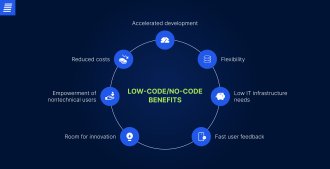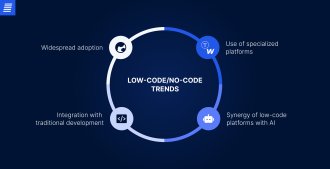
Contact us
Our team would love to hear from you.

Creating your own software is now quicker and more cost-effective. You can avoid the time and expense of buying off-the-shelf software and hiring technical talent by using low-code and no-code platforms. This article will explore what low-code and no-code platforms are, how they differ, their benefits for businesses, and the challenges they may present.
No-code development makes it possible to create apps without writing a single line of code. Instead of a programming language, this method uses pre-built components that can be dragged and dropped to create simple but functional apps. The main benefit of this approach is that it requires little or no technical background.
Low-code software development can be seen as a middle ground between traditional coding and no-code development. It involves minimal coding, using visual, pre-built components along with drag-and-drop interfaces to build apps.
Low-code and no-code (LCNC) development both aim to simplify and accelerate the app creation process by minimizing or eliminating coding. Both approaches allow users to visually select and connect components, each representing specific functions and capabilities, and arrange them into the desired workflow.
However, low-code and no-code software development cater to different users, needs, and project complexities. Key differences include:
| Low-code | No-code | |
|---|---|---|
| Coding | Yes | No |
| Technical background | Yes | No |
| Scalability | More flexible | Limited |
| Customization | More flexible | Limited |
| Platform lock-in | No | Yes |
Low-code and no-code application development platforms are gaining momentum among business owners. Experts project that the global market for low-code platforms will reach approximately $65 billion by 2027. This growth is driven by the numerous benefits these platforms offer.


Low-code/no-code speeds up development, clearing IT backlogs, shortening project timelines from months to days, and enabling faster product launches. Companies report that their low-code platforms make the development process five to ten times faster compared to traditional coding.
Developers can quickly create prototypes and present them to the end users early in the process. This feedback loop enables teams to refine their apps before committing significant resources, thereby minimizing risks and costs.
Deployable in the cloud in most cases, no-code and low-code platforms offer on-demand scalability without the need for upfront investment in IT infrastructure, making maintenance activities less complex and more cost-effective.
In addition to low infrastructure and maintenance expenses, the no-code/low-code approach helps minimize development costs by reducing the number of developers needed to perform hand-coding.
By reducing reliance on specialized developers, who are often costly and in high demand, these platforms democratize software development, allowing team members to bring their ideas to life without requiring extensive technical expertise.
The visual interface provided by these platforms makes it easy to upgrade, change, or enhance the design or functionality of a solution. Moreover, changes made within the platform are often automatically reflected across the app, reducing the risk of inconsistencies and simplifying maintenance.
With low-code/no-code development, there is no need to wait months for an app to be built and launched. You can implement your business idea in weeks, days, or even hours, depending on its complexity.
There’s a reason why low-code and no-code software development methods have yet to replace conventional ones. While they offer significant benefits, they also come with challenges.
First, widespread use of these tools can aggravate the “shadow IT” problem, leading to unauthorized or poorly managed systems. The problem is that citizen developers often build software that doesn’t work or scale properly and then pass it to an IT team that struggles to support the solution, especially if the creator leaves the company.
Of course, this issue can be addressed by entrusting the development process to IT specialists, either an in-house IT department or a third-party vendor. This allows experts to refine and scale the app, ensuring the system functions properly and integrates well with existing infrastructure.
Integration can also be challenging, especially in organizations with complex and diverse IT environments. This issue arises from the limited capabilities of out-of-the-box low-code/no-code platforms, which can lead to compatibility problems and data silos.
To successfully integrate no-code/low-code solutions, organizations may need to invest in middleware or third-party solutions and involve professional developers to bridge the gap between the systems.
Another critical challenge concerns security. Citizen developers, who typically lack coding knowledge, may inadvertently create applications with security vulnerabilities ranging from inadequate data protection to improper access controls, exposing the organization to potential data breaches and compliance issues. A hybrid approach, with citizen and professional developers working together, can help mitigate these security issues.
Another issue organizations using low-code/no-code platforms can encounter is vendor lock-in. When companies invest in a no-code or low-code development,they often find themselves deeply embedded in its specific ecosystem, with proprietary tools, data structures, and workflows that don’t easily integrate with other systems. As a result, if a business opts to switch to a different platform, the transition can involve significant rework, data losses, and financial costs.
To prevent these issues, decision-makers should evaluate not only how well the platform integrates with their current technology stack but also how easily they can migrate to another solution if needed in the future.
These challenges are driving advancements in no-code and low-code development. As a result, integrating low-code/no-code with traditional development is becoming increasingly popular. This trend is expected to grow into a mainstream approach, enhancing processes without compromising functionality or security. Below, we outline additional trends that may shape the future of low-code and no-code development.


Amid the increasing demand for rapid digital transformation and the need for businesses to remain agile in a competitive landscape, no-code and low-code platforms are expected to be widely adopted by a diverse range of companies in the very near future. Small, medium-sized, and large businesses alike can leverage these approaches to develop custom apps and bring ideas to life efficiently and cost-effectively.
AI generates code snippets—or even entire modules, test cases, and documentation— which automates and facilitates the development process while empowering team members without technical backgrounds to create sophisticated apps. Furthermore, integrating AI and its subsets, such as machine learning, into a low-code/no-code app enables features like data-driven forecasts, fraud detection, predictive analytics, and more. This technological synergy unlocks unparalleled opportunities to innovate, streamline app development, and enhance user experiences, suggesting that the role of AI within low-code/no-code development is likely to evolve.
The emergence of low-code/no-code platforms tailored to specific industries or use cases is becoming increasingly common. These platforms offer industry-specific templates and components, making it easier for businesses to develop apps that meet their unique requirements. This trend is particularly relevant for industries with stringent regulations and compliance requirements, such as finance and healthcare.

Redeveloped by our React Native developers to let the Cloud Group offer highly secure and cost-efficient communication in the cloud for businesses and individuals.
As noted earlier, the widespread adoption of low-code/no-code development among businesses of all sizes and in various industries is already in progress. In fact, no-code/low-code platforms can be used to develop a wide range of apps, whether high-demand or low-demand. This approach is particularly effective for the following scenarios:
Quickly develop tools for internal use, allowing your IT team to work on more complex tasks.
Extend support for legacy systems or completely replace them quickly, seamlessly, and cost-effectively.
Swiftly create MVPs or prototypes to test your ideas, gather valuable user feedback, and refine the solution before committing to a full-scale development project.
Access your company data in real time and effortlessly transform it into actionable data grids, visualizations, and essential statistics—all with minimal or even no coding.
Streamline workflows and automate repetitive tasks, such as data entry, reporting, and approval processes, without the need to employ developers.
Quickly build, automate, and manage IoT solutions while enhancing accessibility, reducing development time, and lowering implementation costs.
Switch from monolithic apps to a microservices-based approach with easy-to-use low-code platforms.
Build scalable enterprise apps faster, allowing your teams to focus on strategic business initiatives.
The core concept of low-code/no-code is to simplify the process of app creation, empowering non-developers to build software solutions efficiently and independently, with minimal reliance on IT teams. However, this method is not the right solution for every scenario, and no-code/low-code developers are unlikely to replace traditional coders. Additionally, combining conventional approaches with low-code/no-code methods can address many of the challenges associated with low-code/no-code development.
If you want to harness the benefits of this modern method of software creation while mitigating its risks, contact our versatile experts to discuss your project!

While no-code platforms are typically better suited for small and simple apps, low-code platforms can handle more complex and large-scale projects, especially when combined with traditional development methods.
Some of the most popular low-code and no-code platforms include OutSystems, Mendix, Appian, Microsoft Power Apps, and Bubble, each offering unique features tailored to different use cases and levels of complexity.
Yes, low-code and no-code platforms can be used to build cross-platform apps. Many of these platforms are designed to facilitate the development of apps that work on iOS and Android devices.
When choosing a low-code or no-code platform, start by defining your requirements, including the type of app (web, mobile, or both), functionality, and user base. Next, evaluate the platform’s features, customization options, and integration and scalability capabilities. Consider the cost to ensure it fits your budget and assess the platform’s security measures. Finally, test the platform with a trial to see if it aligns with your goals and user expectations.
Can’t find the answer you are looking for?
Contact us and we will get in touch with you shortly.
Our team would love to hear from you.
Fill out the form, and we’ve got you covered.
What happens next?
San Diego, California
4445 Eastgate Mall, Suite 200
92121, 1-800-288-9659
San Francisco, California
50 California St #1500
94111, 1-800-288-9659
Pittsburgh, Pennsylvania
One Oxford Centre, 500 Grant St Suite 2900
15219, 1-800-288-9659
Durham, North Carolina
RTP Meridian, 2530 Meridian Pkwy Suite 300
27713, 1-800-288-9659
San Jose, Costa Rica
Escazú Corporate Centre, Piso 6
40602, 1-800-288-9659